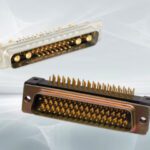Specifying Space Connectors
Space deployment involves major engineering challenges. Evaluating risks and potential problems is an essential part of the process when specifying space connectors.

Space deployment brings a multitude of major engineering challenges, and an essential part of the component selection process involves correctly specifying space connectors. Before deciding on what high-reliability connectors and cable assemblies to design into a space-bound application, many factors need to be considered.
Clearly, once hardware is in space, the repair or replacement of component parts is impractical. Consequently, long-term operational reliability must be assured, so that the risk of malfunction is kept to an absolute minimum. Harsh-environment reliability needs to be addressed simultaneously from various angles and specifying space connectors and cabling involves a solid understanding of the attributes and defined criteria involved in the application. If this is not done effectively, there is potential for poor decisions on the interconnection technology, resulting in mission failure, and the waste of millions of dollars.
Mechanical robustness
Hardware intended for space deployment needs to include an understanding of the heavy mechanical stresses placed upon them during launch. Even after launch, small satellites that are part of a payload consisting of multiple units will be subject to large G forces while being ejected from their launchers. There is also the possibility that, once in orbit, hardware could collide with the many pieces of space junk that are now circling the Earth. Based on all this, it is paramount to specify space connectors that exhibit strong resilience to shocks and vibrations. The inclusion of advanced fixings, either latch or screw locking mechanisms, will be advisable. This will mean that mating pair retention can be improved substantially. Latches will be the preferred option in situations where there is very little available board space, but a screw-based approach will offer better retention characteristics.
Thermal-related issues
Once launched, space-situated hardware is going to be exposed to extreme temperature variations. Satellites in geostationary orbits, for instance, will have to endure constant thermal cycling of their outermost layers. At times, they will have the Sun’s radiation directly on them. Conversely, when they are in the Earth’s shadow, their temperatures will drop dramatically. Thermal cycling is less of an issue if the electronics are situated deep into the center of a relatively large spacecraft, as the direct thermal effects will be much lower. For a CubeSat (maybe measuring just 10 cm x 10 cm) or a PocketQube (with 5 cm x 5 cm external dimensions), however, the impact will unfortunately be felt throughout. The specifications on connectors’ datasheets should be studied to confirm the maximum and minimum temperature range during operation (not just soldering heat resistance). Additional tests relating to thermal soak and thermal cycling should be looked for too, as these will provide extra assurance.
Electrical properties
The ambient environment in which space-deployed interconnects operate is quite different from what is experienced here on the ground. These components will be operating in vacuum or at least partial vacuum conditions, and this will have an influence on their maximum voltage ratings. The voltage at which flashover situations occur is dependent on the density of air molecules. For this reason, the connectors’ voltage ratings at low air pressures should be determined.
The materials science aspect
If connectors are to be used in space-deployed hardware, then they must exhibit harsh-environment reliability, which begins with construction from suitable materials. The metal contacts need to combine durability with high surface conductivity levels. Outgassing, due to exposure to the vacuum of space, can potentially be a concern. This can cause substances that have previously been absorbed into connectors’ constituent materials to be released when under near-vacuum conditions. Unwanted contaminants can thereby be introduced into the space-located systems – affecting the performance of sensitive electronic devices or possibly even leading to irrevocable damage being done to them. NASA and the European Space Agency (ESA) both provide recommended maximum volume levels of outgassing for materials utilized in their space applications. Before a connector model is specified, it is important to check with the manufacturer that the materials featured remain within these levels.
Minimizing size and weight
Space systems have to respect acute constraints – in regard to physical dimensions and payload weight. A CubeSat, for example, could be part of a rideshare mission. The launch operator will only be able to allocate a certain amount of space and weight within the rocket for this unit. Engineers involved in the building of the CubeSat will want to fit as much functionality into its design as possible, but without exceeding the agreed size and weight restrictions. This is why reliance on compact, lightweight components is advantageous. When sourced from the right supplier, use of plastic materials for the housings (instead of metal) can help keep connector weight down while still maintaining sufficient ruggedness.
By installing connectors that have right-angle configurations, valuable room can be saved. This enables arrangements where the connectors are located on PCB edges, and cabling can then be run along the outside. The upshot is that boards may be stacked closer together, as space does not need to be left between them for fitting cabling in. If connectors that have both power and signal transmission contacts are selected, then component counts relating to these functions can be halved, and board utilization markedly lowered in the process. Another way of saving space is via panel-to-panel connector mating. Here connectors are mated together without the need for any cable interface. This also avoids extra cabling contributing to the payload weight.
Cost implications
Getting hardware into space is an expensive business. Though, in the past, projects would generally incorporate aviation-grade custom components, the need to maintain high degrees of harsh-environment reliability must be balanced with budgetary constraints. The New Space phenomena has highlighted this trend even further. Engineers are now looking to use commercial-off-the-shelf (COTS) components in their designs. Not only is this favorable from a financial perspective, but it prevents vulnerabilities when it comes to long lead times.
The panel-to-panel connector mating just mentioned also has cost benefits, as a proportion of the cabling can be eliminated. Likewise, the installation of connectors with power and signal delivery both covered will be more economical.
A figure of merit that is often referred to is currency versus weight. Spaceborne components should be produced using materials that are as light as possible to conserve weight, while still maintaining high mechanical reliability, delivering strong electrical performance and keeping within budget limitations. This can be summarized with the acronym SWAP-C (size, weight, and power versus cost. It balances elevated performance capabilities with acceptable component pricing.
Interconnect sourcing
Through its HRi portfolio of high-reliability connectors, Harwin serves a broad variety of space customers. These span from small-scale academic research projects, through New Space start-up ventures and large commercial satellite communication constellations deployments, all the way to internationally respected space agencies like NASA and ESA, plus high-profile launch service providers.
Harwin’s Datamate and Gecko connector series attain high performance benchmarks alongside prolonged harsh-environment reliability. They feature materials that have industry-leading outgassing properties and can withstand extreme thermal cycling, as well as being robust enough to cope with intense mechanical strains. Their contacts are made from a beryllium-copper compound that is very conductive, but also exceptionally durable. Panel-mount options are available for these connectors, as well as right-angle configurations. Different fixing types can be specified depending on the application requirements.

Harwin’s lightweight plastic-packaged Gecko connector series
The 1.25 mm-pitch Gecko connectors have contacts that are capable of carrying 2A currents. These contacts utilize a proprietary four-finger design, that means there is always at least one mating surface between the contact pin and the corresponding plug, even when shocks and vibrations reaching 50G are applied.

Harwin Datamate connectors with accompanying cabling
Also featuring Harwin’s unique four-finger design, Datamate contacts can handle 3.3A currents. These 2 mm-pitch connectors have an operational temperature range of -55 °C to +125 °C. An extensive array of pin count options helps to maximize layout flexibility. Mix-Tek versions of the Gecko and Datamate connectors reduce board space requirements. Using these, power and data signals can be handled by just a single compact component.
An increasing number of commercial endeavors plus renewed space agency interest in placing humans back on the Moon (and further into the future, potentially on Mars ), are all driving demand for high-reliability COTS interconnects. These components need to possess a certain set of traits if their implementation is to prove successful. Before making any purchasing decisions, it is critical that the models being considered are shown to be up to the job.
To learn more about high-reliability and space-grade interconnects, visit Harwin.
Like this article? Check out our other Harsh Environment, High Reliability, our Mil/Aero Market articles, and our 2022 and 2023 Article Archives.
Subscribe to our weekly e-newsletters, follow us on LinkedIn, Twitter, and Facebook, and check out our eBook archives for more applicable, expert-informed connectivity content.
- Building Resilient Robotic Systems for Harsh Environments - September 19, 2023
- Specifying Space Connectors - July 11, 2023





